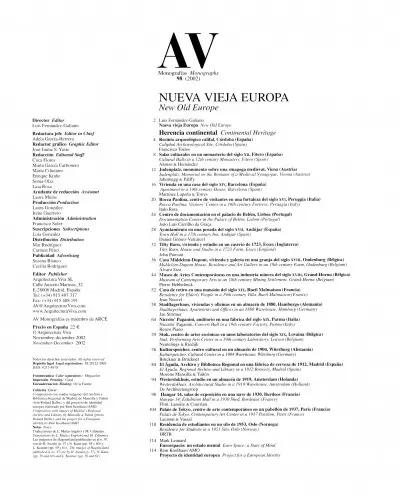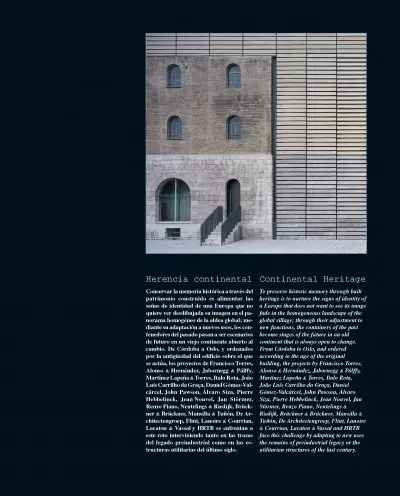NUEVA VIEJA EUROPA
New Old Europe
Luis Fernández-Galiano
Nueva vieja Europa
New Old Europe
Herencia continental
Continental Heritage
Recinto arqueológico califal, Córdoba (España)
Caliphal Archaeological Site, Córdoba (Spain)
Francisco Torres
Salas culturales en un monasterio del siglo XII, Fitero (España)
Cultural Halls in a 12th century Monastery, Fitero (Spain)
Alonso & Hernández
Judenplatz, monumento sobre una sinagoga medieval, Viena (Austria)
Judenplatz, Memorial on the Remains of a Medieval Synagogue, Vienna (Austria)
Jabornegg & Pálffy
Vivienda en una casa del siglo XIV, Barcelona (España)
Apartment in a 14th century House, Barcelona (Spain)
Martínez Lapeña & Torres
Rocca Paolina, centro de visitantes en una fortaleza del siglo xvi, Peruggia (Italia)
Rocca Paolina, Visitors’ Center in a 16th century Fortress, Peruggia (Italy)
Italo Rota
Centro de documentación en el palacio de Belém, Lisboa (Portugal)
Documentation Center in the Palace of Belém, Lisbon (Portugal)
João Luís Carrilho da Graça
Ayuntamiento en una posada del siglo XVII, Andújar (España)
Town Hall in a 17th century Inn, Andújar (Spain)
Daniel Gómez-Valcárcel
Tilty Barn, vivienda y estudio en un caserío de 1723, Essex (Inglaterra)
Tilty Barn, House and Studio in a 1723 Farm, Essex (England)
John Pawson
Casa Middelem-Dupont, vivienda y galería en una granja del siglo xviii, Oudenburg (Bélgica)
Middelem-Dupont House, Residence and Art Gallery in an 18th century Farm, Oudenburg (Belgium)
Álvaro Siza
Museo de Artes Contemporáneas en una industria minera del siglo XVIII, Grand-Hornu (Bélgica)
Museum of Contemporary Arts in an 18th century Mining Settlement, Grand-Hornu (Belgium)
Pierre Hebbelinck
Casa de retiro en una mansión del siglo XIX, Rueil Malmaison (Francia)
Residence for Elderly People in a 19th century Villa, Rueil Malmaison (France)
Jean Nouvel
Stadtlagerhaus, viviendas y oficinas en un almacén de 1880, Hamburgo (Alemania)
Stadtlagerhaus, Apartments and Offices in an 1880 Warehouse, Hamburg (Germany)
Jan Störmer
Niccolo’ Paganini, auditorio en una fábrica del siglo XIX, Parma (Italia)
Niccolo’ Paganini, Concert Hall in a 19th century Factory, Parma (Italy)
Renzo Piano
Stuk, centro de artes escénicas en unos laboratorios del siglo XIX, Lovaina (Bélgica)
Stuk, Performing Arts Center in a 19th century Laboratory, Leuven (Belgium)
Neutelings & Riedijk
Kulturspeicher, centro cultural en un almacén de 1904, Würzburg (Alemania)
Kulturspeicher, Cultural Center in a 1904 Warehouse, Würzburg (Germany)
Brückner & Brückner
El Águila, Archivo y Biblioteca Regional en una fábrica de cerveza de 1912, Madrid (España)
El Águila, Regional Archive and Library in a 1912 Brewery, Madrid (Spain)
Moreno Mansilla & Tuñón
Westerdokhuis, estudio en un almacén de 1919, Amsterdam (Holanda)
Westerdokhuis, Architectural Studio in a 1919 Warehouse, Amsterdam (Holland)
De Architectengroep
Hangar 14, salas de exposición en una nave de 1930, Burdeos (Francia)
Hangar 14, Exhibition Hall in a 1930 Shed, Bordeaux (France)
Flint, Lanoire & Courrian
Palais de Tokyo, centro de arte contemporáneo en un pabellón de 1937, París (Francia)
Palais de Tokyo, Contemporary Art Center in a 1937 Pavilion, Paris (France)
Lacaton & Vassal
Residencia de estudiantes en un silo de 1953, Oslo (Noruega)
Residence for Students in a 1953 Silo, Oslo (Norway)
HRTB
Mark Leonard
Euroespacio: un estado mental Euro Space: a State of Mind
Rem Koolhaas/OMA
Proyecto de identidad europea Project for a European Identity
Luis Fernández-Galiano
New Old Europe
Europe renews itself. Deeply conscious of its age, the old continent tries to rejuvenate with the assimilation of abundant demographic transfusions, the refurbishment of its urban fabric and the regeneration of its sclerotic institutions. This economic giant is however a military dwarf, and the provisional paradise it has built on its small and overpopulated territory, with neither a common language nor a singular leadership, rests on the fragile support of the world’s stability. The recent upheavals have shown both its internal fractures and the risks trapped in an uncertain future: while the core of the continent, in step with public opinion, has moved away from the geopolitics of the Empire, the peripheral countries have preferred the protection of a strong and bellicose America, weaving a chain of nations (formed by Atlantic islands, Mediterranean peninsulae and an archipelago of ex-Communist states) that Washington has baptized the New Europe.
But both the Old Europe of France and Germany and the new one of the British, Spanish, Italian or Polish are Europes of shared problems, similarly subjected to the revitalizing and traumatic impact of immigration, equally devoted to the renovation of their infrastructure and likewise faced with the redefinition of their historic identity. This process of demographic, physical and symbolic rejuvenation finds a privileged ground of expression in the renovation of architectural heritage, an activity rich both in opportunities and conflicts. Whether historic centers colonized by immigrants, obsolete industrial peripheries or monuments absorbed by thematic tourism, the interventions on built heritage constitute an increasing portion of the architect’s work, and a new space for research that touches the very heart of the European dilemmas with the violence of the dentist’s drill, cleaning up cavities and occasionally touching a painful nerve.
Today the concept of heritage has spread steadily from paleonthological and archaeological remains to 20th century buildings, including areas of historic or environmental value, vernacular or industrial architecture, urban or rural landscapes and even that immaterial heritage composed by oral tradition or customs. However, that overwhelming luggage is often perceived as a burden that forces Europeans to travel in time encumbered by trunks or paralyzed by the excess of reminiscence as Funes the Memorious, the character of Borges whose exceptional retention was in the end incompatible with life. We explore the future of the past and perhaps we should rather worry about the past of the future, reconciling the survival of objects with the strategic decisions regarding today’s city that will condition our own ability to survive in the turmoil of change. Only so will this elderly giant regenerate itself, and only so will old Europe become a new one.








